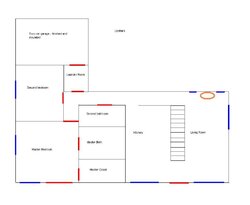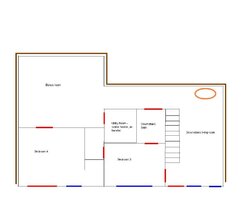My wife and I bought our first home this past April. I'm having problems keeping the house warm. We have two wood burning stoves - a free-standing stove in the basement and an insert upstairs. I've attached two images, which give the layout of the main and lower levels.
The house is 3200 sq. feet, 1600 per level. The main level has a 2 car attached garage (I don't know the dimensions of the garage at the moment, sorry).
The red lines on the images are doors. We have a set of double doors leading out on a small deck from the master bedroom, and a set of double doors in the basement as well.
The blue lines on the images are windows.
The orange circles are the stoves - on the main level is the insert and the lower level is the free standing stove.
The brown line around the outside perimeter of the lower level indicates where the ground is burying or partially burying the foundation.
First, the downstairs stove. This stove seemed great when I first started using it, but I've come to hate it. It ate threw wood like crazy. There is not shutoff for the flue, and no S or J channel, so the hot air just goes right out. Even if I close down the air intake, the fire will roar to ridiculous levels. My dad believes the stove is old and the seams are cracked. It also doesn't burn very long or well...we plan on getting a new one after the first of the year.
However, even when using this stove the upstairs was cool - unpleasantly cool. And our bedrooms, located on the far side, were cold. We had a new HVAC system installed and I had them put a cold air return above the stove...however, it just didnt seem to pump that hot air anywhere.
A chimney repair company recommended that I cut a hole in the side of the house and put an insulated duct line running to the stove, to feed it air from outside. Is that going to do anything? I tried just opening a window across the room, but that didnt seem to do anything...the upstairs and upstairs bedrooms were still cold.
I had the idea of putting vents in the floor above the stove to allow the heat to move up to the main floor - is that worth doing? Perhaps putting one of these in - http://www.tjernlund.com/Retail/aireshare.htm
The basement ceiling is currently open to the frames (mold caused us to have to demo the entire basement), so I also thought about running a duct from above the stove over to the two bedrooms, and installing some kind of temperature controlled fan - once it reached a certain temp in the downstairs living room, the fan turns on and helps move the air to the far end of the house. However, I've read that moving cold air is more efficient, so I'm wondering if this would just be a waste of time?
Until we have our savings back in order (mold remediation was expensive), we're using the stove insert upstairs. It doesn't go through near the amount of wood downstairs does, and it keeps the rooms upstairs drastically warmer. The main living room will be at 75 degrees, bedrooms at 63-65.
Again, the bedrooms are just too cold...I'd like them a little warmer - not crazy warm, but warmer. I run the fan on the insert to blow the heat into the room, and have a box fan blow across the front of the stove down the hallway...still stays cold - better, but not where we want it. I have a few ideas:
The upstairs living room has vaulted ceilings. I have thought about cutting a vent in the wall up in the vaulted section, and running insulated duct work through the attic and down into the two bedrooms. Again, a temperature controlled fan would turn on when the temp was high enough. I've read conflicting opinions, so I'm wondering if folks think this is worthwhile?
After doing some research, I've read that its easier to move cold air than it is warm air. So, instead of trying to move the warm air from the living room with a fan, would it be better to reverse it and blow the cold air from the bedrooms (a return duct low for example) and blow that into the living room somehow?
Or would I benefit from doing all of this, making a whole air movement system throughout the house - almost a second HVAC with some fans and ductwork that pulls cold air from the bedrooms and pumps it into the living room?
Or, are there any other suggestions you folks would have?
Thank you much for any help or suggestions you can provide.
The house is 3200 sq. feet, 1600 per level. The main level has a 2 car attached garage (I don't know the dimensions of the garage at the moment, sorry).
The red lines on the images are doors. We have a set of double doors leading out on a small deck from the master bedroom, and a set of double doors in the basement as well.
The blue lines on the images are windows.
The orange circles are the stoves - on the main level is the insert and the lower level is the free standing stove.
The brown line around the outside perimeter of the lower level indicates where the ground is burying or partially burying the foundation.
First, the downstairs stove. This stove seemed great when I first started using it, but I've come to hate it. It ate threw wood like crazy. There is not shutoff for the flue, and no S or J channel, so the hot air just goes right out. Even if I close down the air intake, the fire will roar to ridiculous levels. My dad believes the stove is old and the seams are cracked. It also doesn't burn very long or well...we plan on getting a new one after the first of the year.
However, even when using this stove the upstairs was cool - unpleasantly cool. And our bedrooms, located on the far side, were cold. We had a new HVAC system installed and I had them put a cold air return above the stove...however, it just didnt seem to pump that hot air anywhere.
A chimney repair company recommended that I cut a hole in the side of the house and put an insulated duct line running to the stove, to feed it air from outside. Is that going to do anything? I tried just opening a window across the room, but that didnt seem to do anything...the upstairs and upstairs bedrooms were still cold.
I had the idea of putting vents in the floor above the stove to allow the heat to move up to the main floor - is that worth doing? Perhaps putting one of these in - http://www.tjernlund.com/Retail/aireshare.htm
The basement ceiling is currently open to the frames (mold caused us to have to demo the entire basement), so I also thought about running a duct from above the stove over to the two bedrooms, and installing some kind of temperature controlled fan - once it reached a certain temp in the downstairs living room, the fan turns on and helps move the air to the far end of the house. However, I've read that moving cold air is more efficient, so I'm wondering if this would just be a waste of time?
Until we have our savings back in order (mold remediation was expensive), we're using the stove insert upstairs. It doesn't go through near the amount of wood downstairs does, and it keeps the rooms upstairs drastically warmer. The main living room will be at 75 degrees, bedrooms at 63-65.
Again, the bedrooms are just too cold...I'd like them a little warmer - not crazy warm, but warmer. I run the fan on the insert to blow the heat into the room, and have a box fan blow across the front of the stove down the hallway...still stays cold - better, but not where we want it. I have a few ideas:
The upstairs living room has vaulted ceilings. I have thought about cutting a vent in the wall up in the vaulted section, and running insulated duct work through the attic and down into the two bedrooms. Again, a temperature controlled fan would turn on when the temp was high enough. I've read conflicting opinions, so I'm wondering if folks think this is worthwhile?
After doing some research, I've read that its easier to move cold air than it is warm air. So, instead of trying to move the warm air from the living room with a fan, would it be better to reverse it and blow the cold air from the bedrooms (a return duct low for example) and blow that into the living room somehow?
Or would I benefit from doing all of this, making a whole air movement system throughout the house - almost a second HVAC with some fans and ductwork that pulls cold air from the bedrooms and pumps it into the living room?
Or, are there any other suggestions you folks would have?
Thank you much for any help or suggestions you can provide.



